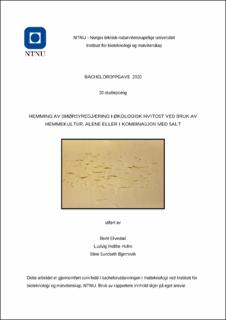| dc.contributor.advisor | Langfoss, Kari Helgetun | |
| dc.contributor.author | Elvestad, Berit | |
| dc.contributor.author | Holm, Ludvig Holthe | |
| dc.contributor.author | Bjørnsvik, Stine Sundseth | |
| dc.date.accessioned | 2020-07-14T16:00:31Z | |
| dc.date.available | 2020-07-14T16:00:31Z | |
| dc.date.issued | 2020 | |
| dc.identifier.uri | https://hdl.handle.net/11250/2664005 | |
| dc.description.abstract | Bakgrunnen for bacheloroppgaven var å hemme smørsyregjæring i økologisk hvitost uten å påvirke ostens smak, modning og konsistens gjennom å benytte hemmekultur, alene eller i kombinasjon med salt. En god del av arbeidet relatert til oppgaven ble gjort i samarbeid med en annen bachelorgruppe som så på effekten av å hemme smørsyregjæring med kun tilsats av salt.
Det ble foretatt ystinger i fire runder som resulterte i totalt sju oster med ulike tilsetninger. To av ostene ble tilsatt omtrentlig lik mengde hemmekultur, to ble tilsatt ulik mengde salt, og én ost hadde en kombinasjon av hemmekultur og salt. To av ostene var kontrolloster uten tilsetning. Da analyser ikke kunne påvise Clostridium tyrobutyricum i én av ysterundene ble ystemelka inokulert med bakterien i siste ysterunde. Alle ostene gjennomgikk ellers lik ysteprosess og modningsforløp. Etter fullført modning ble det gjennomført sensorisk analyse. Det ble foretatt mikrobiologiske prøver under ystingen, samt pH-målinger under hele prosessen. Flere analyser ble foretatt av eksterne aktører, som kjemisk analyse av smørsyremengde. Noe av det mikrobiologiske arbeidet gruppen skulle foreta måtte utgå grunnet situasjonen rundt Covid-19.
Alle oster har smørsyrenivå langt over vanlig verdi for goudaost ved analyse av modnet ost. Begge ostene som var tilsatt kun salt viste redusert smørsyre sammenlignet med kontrollostene. Osten med høyest innhold av tilsatt salt hadde lavest innhold av smørsyre av alle ostene, men saltet hadde påvirket modningsprosessen i stor grad. Ostene ystet med hemmekultur hadde ulik mengde smørsyre selv om de ble tilsatt like mye hemmekultur. Også i ysterunder hvor det ikke var påvist anaerobe sporedannere hadde modnet ost smørsyregjæring. Osten som var tilsatt både salt og hemmekultur viste redusert smørsyregjæring i modnet ost sammenlignet med kontrollost. Ingen av ostene scoret særlig høyt på sensorisk analyse da osten med høyeste poeng fikk 2,2 av 5 mulige.
Selv om mengde smørsyre var for høy var det er en indikasjon på at en kombinasjon av hemmekultur og salt hemmer smørsyregjæring i goudaost. Denne osten scorer også nest best under sensorisk analyse så man antar at ostens smak, modning og konsistens ikke ble påvirket i for stor grad. | |
| dc.description.abstract | The background for this bachelor´s thesis was to inhibit butyric acid fermentation in ecological Swiss/Gouda type of cheese without causing change in the taste, ripening and consistency of the cheese by using protective culture, alone or in combination with salt. An amount of work related to the thesis was done in cooperation with another bachelor group that looked at the effect of inhibiting butyric acid fermentation with the use of salt only.
The cheesemaking was done in four rounds that resulted in a total amount of seven cheeses. Two of the cheeses had a similar amount of protective culture added, two of the cheeses were added a different amount of salt and one cheese got a combination of protective culture and salt. Two of the cheeses were used as reference as they were not added salt or protective culture. Since analyzes gave a negative result for Clostridium tyrobutyricum at one of the cheesemaking rounds the bacteria was inoculated in the cheese milk at the last round of cheesemaking. Other than that, the cheeses had an equal way of production and ripening. When the ripening was completed the matured cheeses went through a sensory analysis. During production there were taken microbiological samples, and pH measurements were taken during the whole process from start to mature cheese. Several of the analyzes, like analyzing the amount of butyric acid in ripened cheese, were undertaken by an external part. Some of the microbiological work the group had planned to do could not be completed as of the situation regarding Covid-19.
Each of the cheeses had a high amount of butyric acid in ripened cheese compared to normal Gouda cheese. Both cheeses that were added only salt showed reduced butyric acid level compared to the reference cheeses. The cheese with the highest amount of added salt had the lowest levels of butyric acid, but the salt had affected the ripening process largely. The cheeses with added protective culture had less butyric acid in mature cheese than the reference cheeses. None of the cheeses got a high score at the sensory analysis, as the cheese with the highest score got 2,2 out of 5 possible points.
Even though the amount of butyric acid present there was an indication that a combination of protective culture and salt inhibit butyric acid fermentation in Gouda cheeses. This cheese also got the second highest score at the sensory analysis, so it is presumed that the taste, ripening and consistency of the cheese is not affected largely. | |
| dc.publisher | NTNU | |
| dc.title | Hemming av smørsyregjæring i økologisk hvitost ved bruk av hemmekultur, alene eller i kombinasjon med salt | |
| dc.type | Bachelor thesis | |
